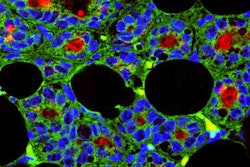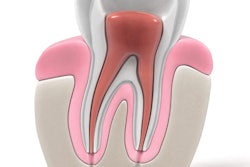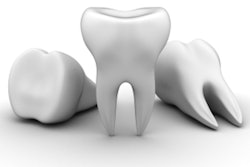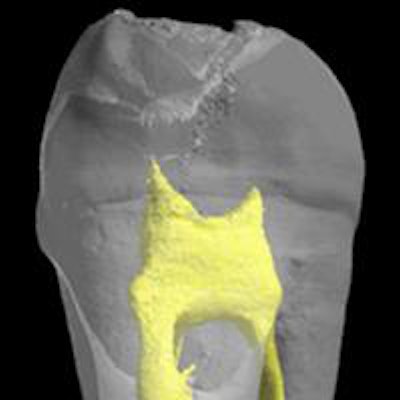
While stem cells have been touted for years as a treatment that may revolutionize dental care, much about how they work and how to design treatment strategies using these cells is still unknown.
Previous research has shown that identifying stem cells in adult tissue is challenging at best. In addition, the precise location of these cells within the pulp has never been determined.
However, French researchers have now extracted and isolated dental stem cells by working on pulp from the molar of a mouse. They studied these stem cell lines to find the natural mechanism by which the cells repair lesions in teeth (Stem Cells, April 11, 2015).
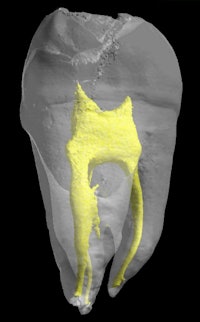 3D model of a tooth, with the pulp in yellow. Image courtesy of INSERM.
3D model of a tooth, with the pulp in yellow. Image courtesy of INSERM."Currently, dentists use pulp capping materials (calcium hydroxide) and tricalcium phosphate-based biomaterials to repair the tooth and fill lesions," corresponding author Odile Kellermann, a biology professor at Paris Descartes University, said in a release. "Our results lead us to imagine unprecedented therapeutic strategies aimed at mobilizing the resident pulpal stem cells in order to magnify the natural reparative capacity of teeth without use of replacement materials."
The researchers from Paris Descartes University and the French Institute of Health and Medical Research (INSERM) were able to identify five specific receptors for the neurotransmitters dopamine and serotonin on the surface of the stem cells. They observed that dental repair did not occur in rats with modified platelets that do not produce serotonin or dopamine.
"In stem cell research, it is unusual to be simultaneously able to isolate cell lines, identify the markers that allow them to be recognized (here the five receptors), discover the signal that recruits them (serotonin and dopamine), and discover the source of that signal (blood platelets)," Kellermann said. "In this work, we have been able, unexpectedly, to explore the entire mechanism."
The presence of the receptors indicated that the stem cells had the ability to respond to dopamine and serotonin if a lesion developed. The researchers then found that blood platelets, activated by the dental lesion, are responsible for releasing large quantities of serotonin and dopamine. After being released, these neurotransmitters recruit the stem cells to repair the tooth by binding to their receptors.
The group also discovered that one of the five specific receptors does not seem to affect the repair process. But, as the other four receptors are significantly involved in the repair process, in vivo blocking of just one is sufficient to prevent repair, according to the researchers.
More investigations are needed to discover other potential progenitors within the pulp that may be mobilized by trauma, the authors concluded.




